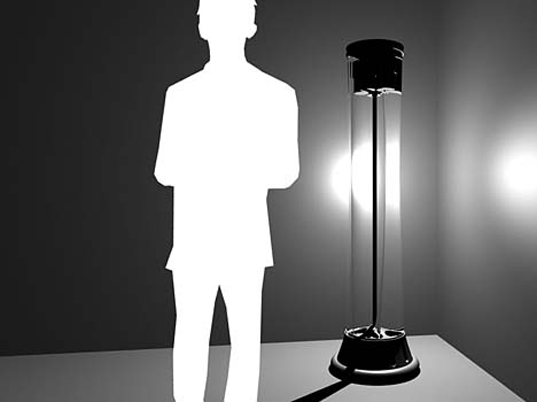
Did a young and promising clean-energy consortium just give a big prize to the wrong guy?
This cool “gravity-based kinetic energy lamp,” Gravia, above, by designer Clay Moulton, placed second at the Greener Gadgets Conference (GGC)’s design competition, held here in New York City, on February 1.
Said the contest summary,
The driving idea of Gravia is that light is generated when the user raises weights from the bottom to the top of the lamp. As the mass slowly falls it spins a rotor. The energy created by the movement is harnessed by an internal mechanism to make electricity. Ten high-output LEDs light the four foot high acrylic column with a diffuse glow (600-800 lumens) for about 4 hours of ambient light.
You can see a schematic here.
Obviously, using gravity for power means environmental cleanliness exceeding the surgical. Gravity is a fundamental, universal force, everywhere, free, abundant.
But there’s a problem with the prize-winning Gravia, a big one:
Gravia isn’t actually manufacturable: “The criticism is that a great deal of weight –- tons — would be required [for it to work] and [, as well,] current LEDs are not sufficiently efficient.” Designer Clay Moulton has acknowledged this fact and says that [“]the current design is probably not possible given current LED technology, but could be soon.”
Needless to say, many attendees were outraged, especially, one ventures, since there were cash prizes involved. Also, it raised the critical question: What was GGC rewarding: Solutions or sci-fi?
According to their web site, the GGC was caught off-guard by the level of hostility to the win, and made this pointed and definitive statement in response.
We were surprised over all the commotion on the engineering feasibility of the lamp, since this was a conceptual design competition after all, and we never stated that designs had to be manufacturable or in production. In fact, the whole point of the design competition was to envision the “future of greener gadgets” – to create designs that are inspirational,and challenge us to imagine the future of greener electronics. By definition the future is often not ‘practical’ or manufacturable in the present. We believe that Gravia is an amazing concept with a lot of potential, despite the design’s lack of accurate engineering specifications. … Despite doubts over the engineering feasibility of the lamp, we were quite taken with the visionary, engaging concept behind the design.
That was all some people needed. This hilarious counter-response typifies others:
Surprised by the “controversy” over the engineering? Why would anyone be surprised? The problems with this are not small — they’re huge. Even if you had one hundred percent efficient light sources (not possible due to those unfortunate laws of thermodynamics) this device wouldn’t work as advertised.
Tell you what: I have a concept for a piece of paper that knows everything that will ever be known, and can therefore answer any question you write on it.
Now, give me my award. It’s a great concept, isn’t it? Inspirational, isn’t it? Who cares that the laws of the universe make it impossible — give me my award!
Really, I demand my reward and attendant publicity. Money would be nice too. My paper idea is just as feasible as this light.
Environmentalist-designers should spend less time with Maya, and more time working on solutions that are not forbidden by the fundamental laws of the universe. This kind of crap is why hucksters like Steorn [link] get airtime.
As my pal Juliette would say, bwaaahahahahahaha….
It might do well for everyone to step back from the brink and drink some water, preferably from a melting glacier. Clearly, on the path to our clean future, there’s a place for the dreamers—including the Maya pros who can make things look cool. There’s also a need for people who say, “I don’t care how it looks: It doesn’t work.” (Or, more often, “I don’t care how it looks: It works.”)
Right now, we may be in the days that the GGC will later look back on as ones where “we made a lot of mistakes.” For the effort to truly fly, a balance will have to be struck between inspirational ideas and merely practical ones. A way to tell breakthroughs from proposals that boil away the laws of physics will have to fashioned. Indeed, green solutions are often technical, primarily. They are deeply social, too, but they are often about finessing known physical and chemical rules.
At the same time, the engineering set should not should not toss the baby, but give it something to eat. The commitment of non-technicians to greenness represents a certain kind of success, already, and one that is not achieved by reciting technical details to neophytes. Instead, it’s a triumph of spirit. The fact that Gravia may not ever work as designed may not be the point. Much of what Michelangelo built did not work, either. Yet, 500 years later, we cannot stop looking at or thinking about what was born in his hands. Let’s keep working on this, working it out, and working together.

0 comments ↓
There are no comments yet...Kick things off by filling out the form below.
Leave a Comment